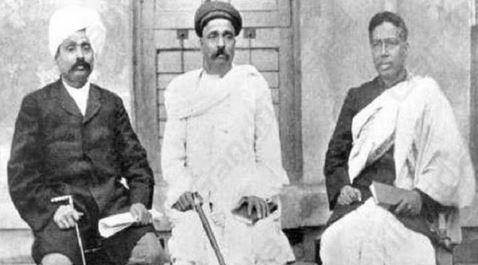The partition of Bengal was the result of the Divide and Rule politics of the colonial British government. After the partition leaders like Surendranath Banerjee, Aurobindo Ghosh, Bipin Chandra Pal, VO Chidambaram Pillai, Babu Genu, etc were sure that the British government will not listen to their demands through petitions and nonviolent means.
Inspired by the Home Rule Movement of Ireland, Indians decided to Boycott the British product to bring down the economy of the British government. Surendranath Banerjee believed that boycotting the British product is the last option of the Indians. On the other hand, Aurobindo Ghosh considered boycott as the first step towards Swaraj (self-rule).

Lal, Bal, Pal. The main leaders of the Swadeshi Movement
Content
Swadeshi Movement: Rise of Nationalism
During the colonial period, the government closely worked with rich businessmen and traders. The leaders of the Swadeshi movement believed that they had to attack the trade market of the then British government and the only possible way was boycotting all the imported British products.
The agitators also decided to boycott schools, colleges, courts, etc. leaders like Bal Gangadhar Tilak and Lala Lajpat Rai (Lion of Punjab) spread this movement across Maharashtra and Punjab. Landowners and farmers also boycotted the use of British products. Later lawyers, teachers, doctors, labor, barbers, and even monks joined the movement.
Due to this initiative, the movement was seen as a huge success. There was a serious loss of material imported by the British government. Silk import suffered a loss of 22%, 44% loss was inflicted on silk threads, 11 % loss on Salt, 55% on Cigarettes, and 68% loss were inflicted on Shoe import. The British government declared the Boycott of the British government as anti-national and anti-Muslim and decided to harshly suppress the movement.
Furthermore, the loss suffered by the rich British businessmen and traders started to pressurize the government to cancel the Partition of Bengal decision.
Impact of Swadesh Movenment
Economic self-reliance
Chakra was declared as the symbol of Economic self-reliance. To boost the manufacturing of indigenous products stores were opened. Emphasis was given to the resurrection of cottage industries.
Indigenous banks, insurance companies, Banga Lakshmi cotton mills, Tuticorin Navigation Company, Mohin mills, Bangla Chemicals were established to promote indigenous products.
Gram Swaraj
Prior to the partition of Bengal, Rabindranath Tagore (Gurudev) focused on bettering the condition of villages through cottage industries. Later in the Swadeshi movement, the reforms were done in law and order at the village level. Later Gandhi drew the inspiration of Gram Swaraj from the Swadeshi movement.
National Education
During the colonial period, the British were introducing a western style of education. The leaders of the movement decided to establish national schools which were inspired by Indian culture and traditions.
Satish Chandra Mukherjee the editor of the weekly newspaper DAWN, gave the idea of National Education. Under the Swadeshi movement, the National Council of Education was set up in Bengal. Bengal Technical Institute was also opened in 1906.
Bengal National College was opened in 1906 whose objective was to provide technical education along with the importance of human character.
National Unity
Swadeshi movement was perhaps the first movement that emphasizes the matter of National Unity. It was the first movement that was not limited to only a particular community, religion, race, etc. In Maharashtra Bal Gangadhar Tilak, Lala Lajpat Rai in Punjab, Madan Mohan Malviya, C.Y. Chintamani in south India worked to bring national unity among the Indians.
Swadeshi movement was perhaps the first movement that emphasizes the matter of National Unity. It was the first movement that was not limited to only a particular community, religion, race, etc. In Maharashtra Bal Gangadhar Tilak, Lala Lajpat Rai in Punjab, Madan Mohan Malviya, C.Y. Chintamani in Southern India worked to bring national unity between the Indians.
Idea of Swarajya
“Swaraj is my birth right and I shall have it.” Bal Gangadhar Tilak
For the first time, the word Swarajya was used by the Indian leaders to achieve their goals. Later the Home Rule Movement of B.G. Tilak and Annie Besant, Non-Cooperation Movement of Mahatma Gandhi drew their inspiration of Swarajya from Swadeshi movement.
Annulment of Partition
Due to mass political protest, the British government decided to annul their decision of Partition of Bengal. Although this decision was taken in 1911 it was the first time in India that the British decided to cancel their decision.

The main person responsible for the Partition of Bengal
The government also shifted the capital from Calcutta to Delhi and also created a separate province of Assam.
Despite the annulment, the British were able to divide Hindu Muslim unity, and with the formation of the Muslim League (in 1906) which later demanded a separate nation of Pakistan prove to be a success for the British government.
LIKE WHAT WE ARE DOING? DONATE TO DHARMAYUDH !
If you Support what we are doing and would like to contribute to help us grow and reach more Indians to teach them more about such forgotten historic Indian Heroes and stories, please consider donating any amount. It will help us grow.

